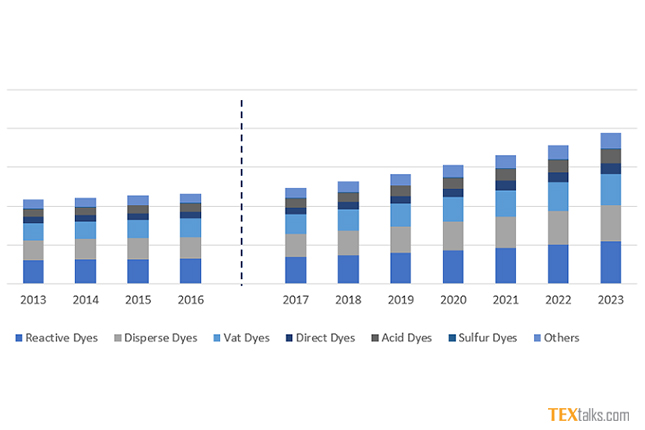According to the new study published by P&S Market Research, the ASEAN & South Asia dyestuff for textile market is forecasted to Reach $1,938.9 Million by 2023. The growth of the ASEAN and South Asia dyestuff for textile market is mainly driven by the tremendously high demand of dyestuff from the home textile and automotive textile industries, in emerging economies.
The ASEAN and South Asia dyestuff for textile market was valued at $1,163.6 million in 2016 and is projected to witness a CAGR of 7.8% during the forecast period. The growing application of dyestuffs in apparels, home textile, and automotive textile is driving the growth of the dyestuff for textile market, for ASEAN and South Asian countries.

By country, India has been the largest market for ASEAN and South Asia dyestuff for textile and is also expected to grow at a significant rate during the forecast period. The shutdown of many dyes and related intermediate units in many developed countries, owing to stringent environmental regulations, has actually worked as a ‘blessing in disguise’ for companies and firms in India, as this has led to a sharp spurt in the prices of several dyes and related products in emerging economies. The closure of the Chinese, European, and the U.S. units has led to a shortage of products in the market, which has raised the demand for dyestuff in emerging economies such as India. This has given birth to new opportunities for the players of dyestuff for textile market in India, and has hence, propelled the growth of the ASEAN and South Asia dyestuff for textile market.
The dyestuff for textile is regularly developed and enhanced to cater to the demands of new kinds of fabrics, by bringing advancements in dyeing machineries, to overcome the serious environmental concerns caused by existing dyes. Such extensive research and developments in dyestuff are further accelerating the growth of the ASEAN and South Asia dyestuff for textile market.
Dyestuffs are water-soluble inexpensive substances that are used to impart color to fabrics. Dyestuffs comprise of products such as dyes, pigments, intermediates, and azo acids.
Market Dynamics
The major factors driving the growth of the ASEAN and South Asia dyestuff for textile market are increase in the demand for technical textiles, high growth in the apparel market, and increase in government support for the development of textile industry. It is expected that maximum demand of this chemical will come from its use as a coloring agent, from home textile industry.
Trends
High use of waterless dyeing is one of the major trends witnessed in the ASEAN and South Asia dyestuff for textile market. In the textile industry, water is used as a primary medium, in which the dye colorant is mixed for polishing and other applications. It is estimated that on an average, about 100-150 liters of water is required to process one kilogram of textile material. After undergoing a variety of textile processing steps, this water turns into wastewater, containing a complex mixture of organic and inorganic chemicals. Hence, a large volume of wastewater is originated in textile mills. Therefore, many key players in the ASEAN and South Asia dyestuff for textile market, such as DyeCoo, and ColorZen LLC., are working towards reducing the usage of water by adopting recycling, conserving, dye sublimation, and other new waterless dyeing technologies.
Apart from this, the high adoption of natural dyes for fabric coloring is another major trend witnessed in the ASEAN & South Asia dyestuff for textile market. Natural dyes have amazing wellness benefits, are renewable, and eco-friendly.
Drivers
The rise in governmental support for the development of and innovation in the textile industry, fuels the growth of the ASEAN and South Asia dyestuff for textile market. For instance, the government of Indonesia targets to increase the nation’s value of exported textiles and garments to $75.0 billion, by 2030. With this, Indonesia aims to increase its contribution to global exports by 5%. In addition, the availability of low-wage labor & raw materials in emerging economies, and large installation of textile plants & factories, further propels the growth of the market in developing countries. For instance, in 2014, the government of India set up Scheme of Integrated Textile Parks, with the aim to assist small and medium entrepreneurs of the textile industry by providing them financial support. This further accelerates the growth of the textile industry, which in turn fuels the demand for dyestuffs for textile.
Restraints
The high cost of dyestuffs restricts the growth of the ASEAN and South Asia dyestuff for textile market. For instance, one pound of cotton requires 230 grams of natural dye. Hence, it is expensive to use natural dyes for fabric coloring. Apart from this, wastewater generated from the textile industry comprises of a mixture of hazardous and polluting substances, including dyes, organochlorine-based pesticides, and heavy metals. It has been estimated that about 280,000 tons of dyes are discharged in textile industrial effluents, every year. This creates environmental hazards and hampers the growth of the ASEAN and South Asia dyestuff for textile market.
ASEAN & South Asia Dyestuff for Textile Market Competitive Landscape
Some of the key players operating in the ASEAN and South Asia dyestuff for textile industry are Huntsman Corporation; Krishna Dyestuff Company; Monarch Dyestuffs Industries and Exports Ltd.; Sumitomo Chemical Company, Limited; Lanxess AG; E.I. du Pont de Nemours and Company; BASF SE; Atul Ltd.; Hangzhou Sunshine Chemicals Co., Ltd; and Arkema Group.



